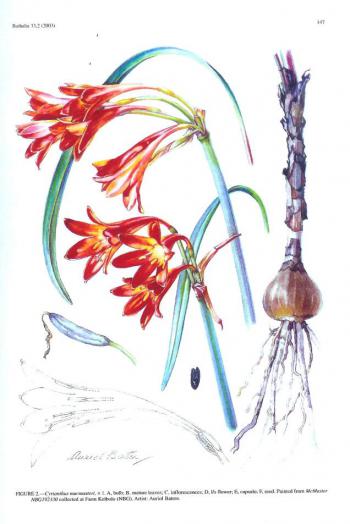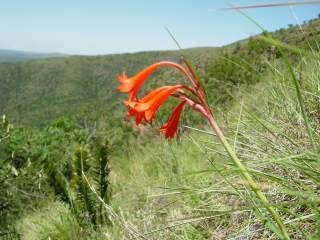Cyrtanthus macmasteri
Cyrtanthus macmasteri Snijman
Family: Amaryllidaceae
Common names:
Introduction
Cyrtanthus macmasteri was described in 2003 after being found in 1994 by naturalist Cameron McMaster at the Bolo River Gorge in the Eastern Cape.

Description
Description
Cyrtanthus macmasteri is a perennial, bulbous herb that is between 200-250 mm high. One or two leaves emerge months before flowering, often dying before flowering and appearing anew after flowering. Each plant produces 3-6 flowers. Flowers are red, large, non-scented, flared and produce nectar. Although the main flowering time is February, C. macmasteri may flower in late January and early March if conditions are favourable. Seeds ripen at the end of March and by mid-April they have mostly dispersed.

Conservation Status
Status
Following the IUCN Red List Criteria, Cyrtanthus macmasteri has been assessed as Vulnerable D2 in 2005 by J.E. Victor and C. Macmaster, the species existing only in two locations. The most severe threat is habitat loss due to land redistribution, since overstocking could lead to suitable habitats becoming degraded. It is also potentially threatened by agriculture.
Distribution and habitat
Distribution description
This species is known only in thick grass between rocks along the steep east- and south-facing banks of the Great Kei River and its tributaries, the Bolo and Nqancule Rivers in the Eastern Cape. The singly grown bulbs are widely scattered though not abundant.

It is confined to altitudes of 640-1 100 m, mostly amongst fine sandstone of the Beaufort Group and also expands into soils weathered from dolerite.
Derivation of name and historical aspects
History
The genus name Cyrtanthus refers to the curved perianth tube of many of the species and is derived from the Greek kyrtos meaning curved and anthos meaning flower. Cyrtanthus macmasteri was named after amateur botanist Cameron McMaster for his invaluable contributions to the Eastern Cape flora. Cameron McMaster did the follow-up work to locate where the species grew and obtained specimens, so the necessary documentation could be done for verifying and naming this rarely seen species.
Ecology
Ecology
Little is known about the pollinators and adaptations of Cyrtanthus macmasteri to the environment since this is a recently described species.
Uses
Use
Cyrtanthus macmasteri is exceptionally rare in cultivation, presently only being grown at Kirstenbosch Botanical Garden and perhaps one other nursery. No medicinal or economic uses are recorded for this plant.
Growing Cyrtanthus macmasteri
Grow
This species shows evidence of horticultural potential, but due to its delicate nature and the difficulty in cultivating, its greatest potential lies in its use as a container plant.
According to Graham Duncan who maintains the bulb collection at Kirstenbosch, Cyrtanthus macmasteri is best grown in pots and needs a very well-drained, sandy medium such as equal parts of coarse river sand and silica (swimming pool) sand, with a 2 cm layer of well-decomposed compost at the bottom of the container. The plants like bright light for the whole day or morning sun and afternoon shade.
Cyrtanthus macmasteri, being deciduous, should be kept as dry as possible in winter and requires a good watering about once per month in summer. It should be noted that this genus is generally not tolerant of severe frost. Cyrtanthus bulbs are not lifted and replanted each year because of their perennial fleshy roots. Once planted, the bulbs should be left undisturbed for several years until they become congested.
References
- Duncan, G.D. 1990. Cyrtanthus — its horticultural potential, part 1. Veld & Flora 76: 18-21.
- McMaster C. 2004. Cyrtanthus macmasteri. Veld & Flora 90: 20-23.
- Foden, W. SANBI Threatened Species Redlisting Database.
- Snijman, D.A. 2003. A new Cyrtanthus species (Amaryllidaceae: Cyrtantheae) endemic to the Albany Centre, Eastern Cape, South Africa. Bothalia 33: 145-147.
Credits
Suvarna Parbhoo
Pretoria National Botanical Garden
October 2006
Plant Attributes:
Plant Type: Bulb, Perennial
SA Distribution: Eastern Cape
Soil type: Loam
Flowering season: Late Summer
PH:
Flower colour: Red
Aspect: Full Sun, Morning Sun (Semi Shade)
Gardening skill: Challenging
Special Features:
Horticultural zones







Rate this article
Article well written and informative
Rate this plant
Is this an interesting plant?
Login to add your Comment
Back to topNot registered yet? Click here to register.